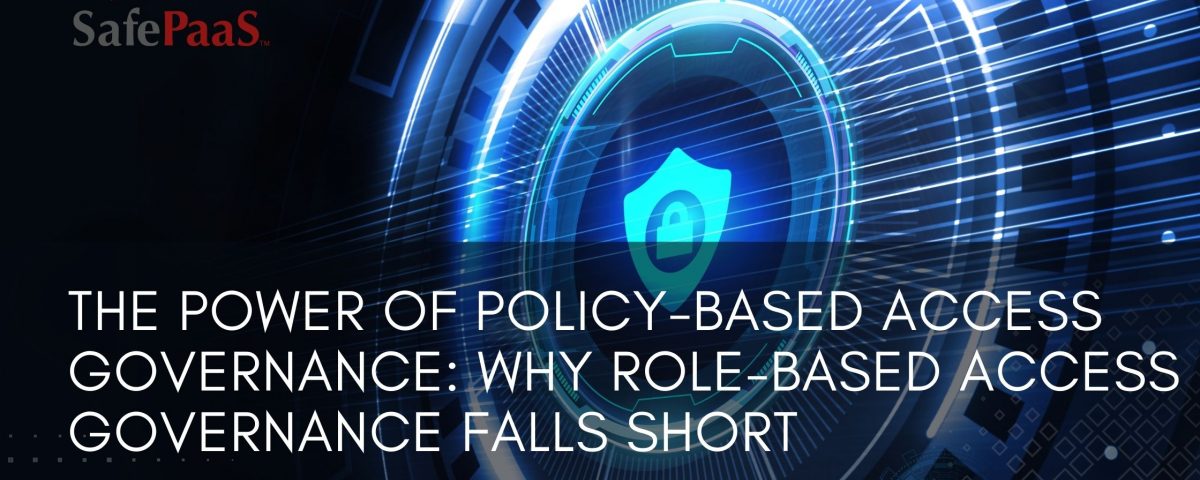The Power of Policy-Based Access Governance: PBAC vs RBAC


Policy-Based Access Governance vs Role-based (PBAC vs RBAC)
Why Role-Based Access Governance Falls Short
Cybersecurity and data protection has gained significant attention in recent years, with an increasing focus on the potential threats and attacks faced by organizations, governments, and individuals. Access governance plays a pivotal role in safeguarding an organization's digital assets. While role-based access governance has long been the norm, it's time for a stronger approach that also increases your flexibility: policy-based access governance.
In the third blog in our latest blog series, "Top Five Access Governance Google Searches - Answered," we will explore what role-based access is, its shortcomings, the rise of policy-based access governance, how it solves the access problems facing the modern enterprise and why policy-based access governance is the future.
Understanding Role-Based Access Governance
Role-based access governance, or RBAC, is a method of defining and managing access controls in which permissions are associated with specific roles within an organization. Users are assigned roles based on their job titles or functions, and these roles dictate the access rights they have. This approach is relatively straightforward and has been widely adopted for decades. However, it has limitations that make it less suitable for today's complex and dynamic business environments.
Why Role-Based Access Governance Falls Short
Inflexibility: Role-based access is rigid and may not adequately address the unique access requirements of individuals or specific situations. It tends to provide either too much or too little access without the fine-grained control necessary for modern security needs.
Entitlement Creep: Over time, as employees change roles or responsibilities, they may accumulate permissions that are no longer relevant. This leads to a phenomenon known as "entitlement creep," where users accumulate access rights they shouldn't have, creating security vulnerabilities.
Complexity and Scale: As organizations grow and diversify, managing access controls through roles becomes increasingly complex. Maintaining role structures and ensuring they align with the ever-changing needs of the business is a formidable task.
Regulatory Compliance: Many industries are subject to stringent regulatory requirements, such as GDPR, HIPAA, or SOX. Role-based access often struggles to meet these demands, as it doesn't provide the level of control and auditability necessary for compliance.
Dynamic Work Environments: In the age of remote work, cloud computing, and collaboration with third parties, employees require access from various locations and devices. Role-based access may not offer the necessary adaptability to accommodate these diverse needs.
The Rise of Policy-Based Access Governance
Policy-based access governance, on the other hand, is designed to address these shortcomings. It focuses on defining access controls through policies based on real-time contextual information. This means access decisions are made by considering factors like user attributes, device information, location, and time of access. Here's why policy-based access governance is better suited for modern enterprises:
Fine-Grained Control: Policies allow organizations to set precise, conditional access rules. For example, access can be granted to a specific application only if the user is within the corporate network and using a company-managed device.
Adaptive Security: Policy-based access can adapt to changes in user roles, responsibilities, and the security landscape. It allows for immediate adjustment of access based on evolving needs.
Risk Mitigation: By continuously evaluating risk factors, policy-based access governance helps identify and respond to security threats proactively, reducing the potential for data breaches.
Compliance: Policies can be designed to meet the strictest regulatory requirements, providing organizations with a greater level of confidence in their compliance efforts.
User Experience: With policy-based access, legitimate users are less likely to encounter roadblocks, as the system can make more informed, real-time access decisions.
Increasing cyber threats, remote work, and stringent compliance demands require organizations to adopt a more dynamic and responsive approach to access governance. While role-based access governance has been a foundation of cybersecurity for many years, it's becoming increasingly inadequate for modern enterprises.
Policy-based access governance offers the agility and precision needed to secure today's complex business environments. Making access decisions based on real-time context and risk factors helps organizations stay ahead of security challenges, adapt to evolving requirements, and ensure compliance. In essence, it's a forward-looking approach that promises to enhance security, reduce risks, and streamline access management in the digital age.
Recommended Resources

The Policy-based Identity Governance Guidebook
Many organizations grapple with IGA processes, like creating and managing roles, assigning and reviewing access entitlements, and handling access requests. The primary cause is that organizations follow the wrong approach to IGA, particularly around creating and managing roles.

Why you need PBAC IGA for ERP systems
This five-part blog discusses why IDM alone is not enough to protect your ERP. This series explores the following topics, The four threats to your ERP posed by user access request management, Top 7 Challenges with IAM, A risk-based approach to application access governance...

The Definite Guide to Modern IAM
Identity security enables organizations to centrally manage their expanding perimeter, including mobile and remote users and on-premises, multi-cloud, and hybrid infrastructure.Consequently, an identity platform is necessary to manage accounts across the organization’s applications.

